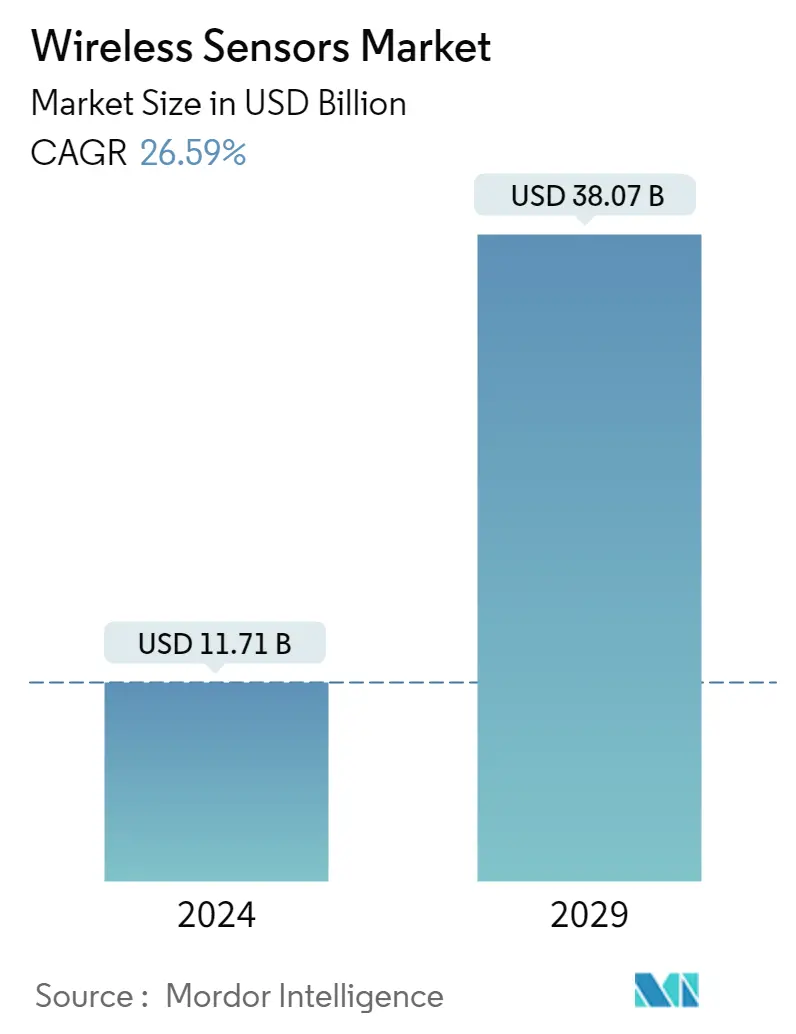Market Size of Wireless Sensors Industry

| Study Period | 2019 - 2029 |
| Market Size (2024) | USD 11.71 Billion |
| Market Size (2029) | USD 38.07 Billion |
| CAGR (2024 - 2029) | 26.59 % |
| Fastest Growing Market | Asia Pacific |
| Largest Market | North America |
Major Players
*Disclaimer: Major Players sorted in no particular order |
Need a report that reflects how COVID-19 has impacted this market and its growth?
Wireless Sensors Market Analysis
The Wireless Sensors Market size is estimated at USD 11.71 billion in 2024, and is expected to reach USD 38.07 billion by 2029, growing at a CAGR of 26.59% during the forecast period (2024-2029).
Wireless sensors offer several advantages, such as accuracy and reliability, with the help of various innovative technologies, such as RFID and Bluetooth, and the potential to make electronic devices easy to integrate. As a result, they gained significant traction in the past few years. These sensors are primarily used in factory settings for data monitoring production flow. These also find applications in Automotive, defense, building automation, and other industries, like materials handling and food and beverage. Due to the increasing quest for new energy sources, government regulations, renewable energy development, and rapid technological advancements, the wireless sensors market is propelling.
- Wireless sensors are considered a vital component in smart grids for remote monitoring of power lines and transformers. They are present in service to monitor line temperature and weather conditions. Industrial automation and demand for miniaturized consumer devices across regions, such as wearables and IoT - connected devices, are among the significant factors driving the wireless sensors market.
- Due to the increased government regulation for the increased use of the sensor for safety, the demand for wireless sensors is growing. For instance, the areas with challenging environmental conditions, such as Oil rigs, Boilers, etc., present high pressure, high temperature, etc. Wireless sensors make it easy to control and monitor the facility from a safe distance.
- The industry 4.0 revolution, in which machines are becoming brighter and more intuitive, is increasing the need for wireless sensors' industrial applications. The new devices are designed to be more efficient, safe, and flexible, with the ability to monitor their performance, usage, and failure autonomously. These applications, therefore, spur the demand for highly- sensitive sensors.
- The rising adoption of IoT is another major factor driving the market's growth. This growth in IoT-connected devices is projected to fuel the demand for wireless sensors. Further, transforming the development of smart homes and buildings, smart cities, and intelligent factories demands wireless sensors, owing to the small form factor, high precision, low power consumption, and ability to control ambient parameters.
- These sensors have reduced installation costs and minimal disruption to the workforce and interiors; therefore, installing wireless sensor systems requires no wiring or structural building changes. Many companies are investing in wireless technologies, which are cost-effective, safe as well as convenient.
- For instance, Monnit Corporation recently announced its ALTA Soil Moisture Sensor's availability to meet the AgriTech market's demands. The innovative Soil Moisture Sensor assists farmers, commercial growers, and greenhouse managers in easily connecting their precision irrigation operations to the Internet of Things (IoT). The defense sector is embracing wireless sensor technology, as these sensors can monitor their premises, identify suspicious activity, and track valuable assets.
- However, the demand for high-performance, cost-efficient, and reliable sensors has increased, leading to higher spending in R&D activities by market vendors. These technological advancements in nanotechnology and micro-technology are expected to propel the market growth of wireless sensors over the forecast period.
- The COVID-19 pandemic is rushing the adoption of Industry 4.0, propelling businesses across industries to a more advanced level of IoT technology and workflow. As a result, pressure sensors will impact manufacturing, maintenance, and human resources, with new and thorough information on consumers' particular use cases. However, COVID-19 created a demand for wireless sensors in the healthcare industry. As countries work to contain the pandemic, the need for effective diagnostic testing has been front and center.
